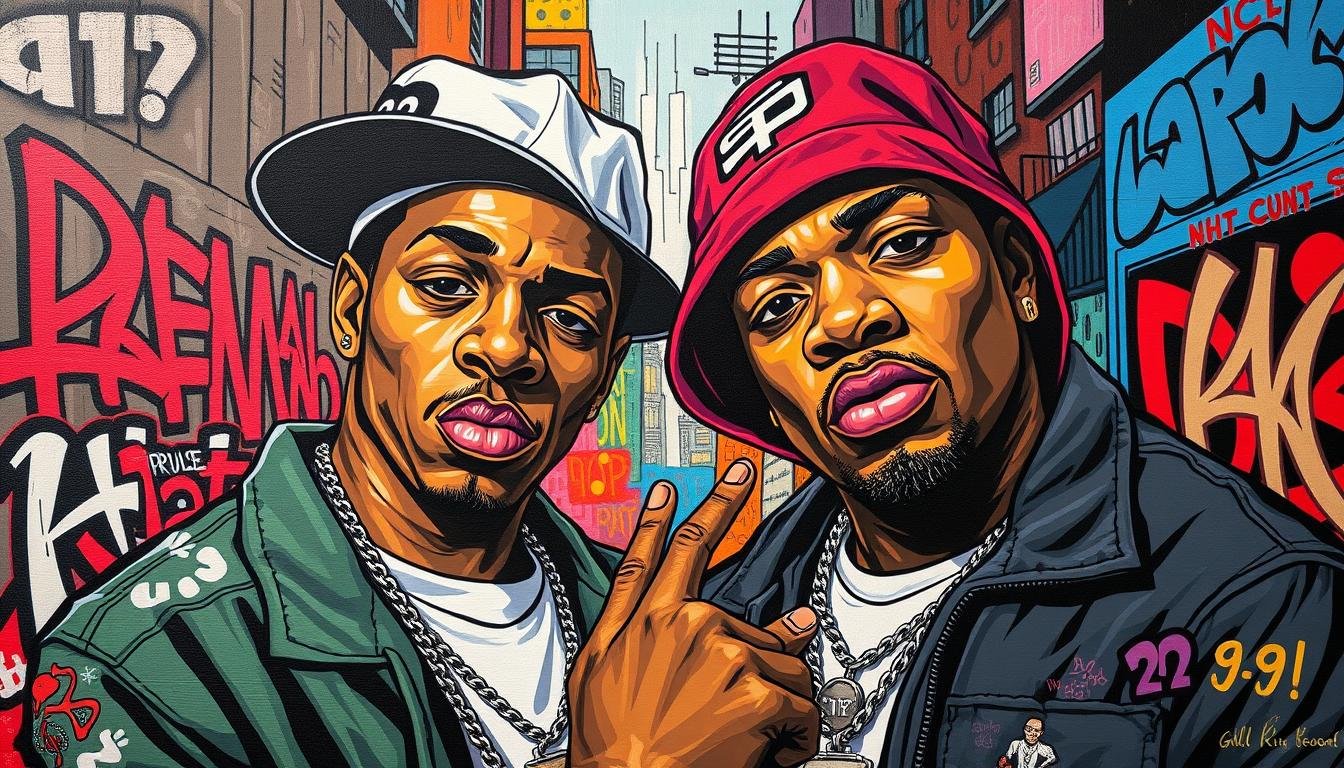Diddy and Tupac’s relationship has fascinated hip-hop and pop culture for years. These rap icons left an unforgettable mark on the music industry. Their intertwined paths shaped the evolution of hip-hop and cultural landscape.
This article explores the untold story of their connection. We’ll dive into the rise of these legends and their first meetings. We’ll also examine how their dynamic influenced hip-hop’s development.
Key Takeaways
- Diddy and Tupac were two of the most influential figures in the golden age of hip-hop in the 1990s.
- Their paths crossed in various ways, from collaborations to business rivalries, shaping the landscape of the music industry.
- The East Coast vs. West Coast rivalry and its impact on their relationship is a crucial aspect of their story.
- The tragic events surrounding Tupac’s death in 1996 left a lasting mark on the hip-hop community and Diddy’s own reflections.
- The legacies of Diddy and Tupac continue to inspire and influence the next generation of artists and fans.
The Rise of Two Hip-Hop Icons in the Early ’90s
In the ’90s, Tupac and Diddy emerged as influential hip-hop artists. Their unique paths to fame sparked a rivalry that would shape the genre for years.
Tupac’s Journey from Digital Underground to Solo Stardom
Tupac Shakur began his career with Digital Underground as a dancer and rapper. His talent and charisma quickly caught the industry’s eye.
Soon, Tupac launched a solo career. This move established him as a ’90s ‘gangsta rap’ icon.
Diddy’s Transition from Talent Scout to Music Mogul
Sean “Diddy” Combs made his mark as a talent scout and artist manager. His ability to spot young talent led him to create Bad Boy Records.
Bad Boy Records became a powerhouse in ’90s hip-hop. It produced influential artists like the Notorious B.I.G.
Parallel Paths to Fame
As Tupac and Diddy’s careers grew, their paths began to cross. This intersection set the stage for a captivating music rivalry.
Their different styles and locations fueled an East Coast vs. West Coast dynamic. This rivalry deeply impacted the hip-hop industry and culture.
| Tupac | Diddy |
|---|---|
| Emerged from Digital Underground | Transitioned from talent scout to music mogul |
| Became a ‘gangsta rap’ icon | Established Bad Boy Records |
| Represented the West Coast | Represented the East Coast |
Initial Encounters: When Diddy First Met Tupac
Diddy and Tupac’s paths crossed in the early ’90s. This era was crucial for both emerging hip-hop stars. Their first meetings laid the foundation for a complex relationship.
Sean Combs, known as Diddy, was rising as a talent scout. Tupac was launching his solo career after leaving Digital Underground. They recognized each other’s potential to become rap icons.
Reports suggest they met at a music industry event. Tupac admired Diddy’s talent-spotting skills. Diddy saw Tupac’s raw talent and charisma.
They explored a possible professional partnership. However, their relationship would later become strained. The East Coast-West Coast rivalry and label competition created tensions.
| Year | Event | Relationship Dynamic |
|---|---|---|
| Early 1990s | First meeting at industry event | Mutual respect and interest in collaboration |
| Mid-1990s | Escalating tensions between Bad Boy and Death Row | Relationship becomes strained due to East Coast-West Coast rivalry |
Their early encounters sparked a fascinating relationship. It became entwined with their journeys to become rap icons and hip-hop legends.
The Death Row vs Bad Boy Records Dynamic
In the 1990s, Death Row Records and Bad Boy Records sparked a fierce rivalry. This clash shaped hip-hop culture, pitting artists against each other. It ignited a competition that echoed throughout the genre.
Business Rivalries and Label Competition
Suge Knight of Death Row and Sean “Diddy” Combs of Bad Boy led the charge. They fought for dominance in hip-hop through aggressive marketing and strategic moves.
Their rivalry became synonymous with the east coast vs. west coast feud. It gripped the music world and divided fans across regions.
Impact on Hip-Hop Culture
The Death Row vs. Bad Boy clash deeply affected hip-hop culture. Each label’s music, fashion, and attitudes represented regional differences.
This rivalry fueled debates about hip-hop authenticity. Both sides claimed to embody the genre’s true essence.
Key Players and Influences
- Tupac Shakur, Death Row’s icon, engaged in lyrical battles with Bad Boy artists.
- The Notorious B.I.G., Diddy’s protégé, intensified the east vs. west coast rivalry.
- Dr. Dre and Nas navigated complex alliances in this heated era.

The Death Row vs. Bad Boy rivalry left a lasting impact on music. It shaped hip-hop’s cultural landscape for years to come.
This competition defined the era and influenced artists’ creativity. It also affected public perceptions of those involved.
Behind the Scenes: Diddy Tupac Business Relations
The ’90s hip-hop scene saw a complex relationship between Diddy and Tupac. Their professional ties mixed collaboration and competition. Beyond music rivalry, their business dealings reveal intriguing interactions between these rap icons.
Diddy and Tupac explored joint ventures behind the scenes. They recognized the potential of combining their creative forces. This was despite growing tensions between their record labels.
Industry insiders buzzed about a possible Diddy-Tupac album or tour. Such a collaboration would have thrilled fans of rap icons. It could have redefined the music rivalry in ’90s hip-hop.
The East Coast-West Coast rivalry complicated their business relations. Each side sought an edge in the changing music rivalry landscape. This made potential collaborations increasingly difficult.
The full story of their dealings remains unknown. Yet, a Diddy-Tupac collaboration remains an intriguing “what-if” in hip-hop history. It continues to fascinate fans of rap icons and ’90s hip-hop.
The East Coast vs West Coast Rivalry’s Impact
The East Coast and West Coast hip-hop rivalry deeply affected music and culture. Diddy and Tupac personified this tension. Media coverage amplified the conflict between these hip-hop legends.
Media’s Role in Escalating Tensions
Media outlets intensified the East Coast vs West Coast rivalry. They pitted Diddy and Tupac against each other for dominance. This attention forced both artists to defend their labels and regional identities.
Cultural and Musical Implications
The rivalry split the hip-hop community. Fans and artists often chose sides. This divide showed in the music, with regions developing distinct styles.
The impact of this rivalry remains in modern hip-hop. The east coast vs west coast dynamic shapes the genre’s identity. It influences how artists, fans, and the industry interact with music.
| East Coast | West Coast |
|---|---|
| Diddy and Bad Boy Records | Tupac and Death Row Records |
| Lyrical focus on storytelling and social commentary | Emphasis on gangsta rap and West Coast lifestyle |
| Soulful, sample-heavy production | Funk-influenced, bass-heavy beats |
| Iconic artists: Notorious B.I.G., Jay-Z, Nas | Iconic artists: Dr. Dre, Snoop Dogg, Ice Cube |
The east coast vs west coast rivalry changed hip-hop’s cultural landscape. Media coverage fueled the conflict between hip-hop legends. This divide still affects how we view rap beef and hip-hop music’s evolution.
Collaborative Opportunities That Never Materialized
Diddy and Tupac were giants in ’90s hip-hop. Their rivalry overshadowed potential collaborations that could have transformed the industry. Imagine the impact if these two had joined forces.
Fans dream about the hits they might have created together. Diddy’s business skills and Tupac’s lyrical genius could have pushed boundaries. Their combined talents might have reshaped influential artists and ’90s hip-hop.
- Unrealized Collaborations: Diddy and Tupac were at their peak in the mid-1990s. Yet, they never worked on a major project together.
- Creative Synergy: Their combined skills could have produced groundbreaking albums and performances. This partnership might have changed the diddy tupac hip-hop scene forever.
- Missed Opportunities: As label rivalries grew, chances for collaboration faded. Fans missed out on a potentially game-changing influential artists partnership.
The Diddy-Tupac collaboration remains a big “what-if” in ’90s hip-hop history. Music fans still wonder how it could have changed the genre.
Their unfulfilled partnership continues to fascinate hip-hop enthusiasts. Many ponder how different music might be if they had worked together.

The Night Everything Changed: Vegas 1996
On September 7, 1996, Las Vegas witnessed a tragic event. It altered the lives of two iconic rappers – Tupac Shakur and Sean “Diddy” Combs. Tensions in the gangsta rap scene had reached a critical point.
The growing rap beef set the stage for a night of infamy. This event would echo through hip-hop history for years to come.
Events Leading Up to September 7
Months before, rivalry between Tupac’s Death Row Records and Diddy’s Bad Boy Records intensified. The iconic rappers found themselves on opposite sides of a growing divide. The East Coast vs. West Coast conflict had gripped the industry.
On September 7, Tupac and Diddy attended a Mike Tyson boxing match. The event drew many music industry figures to the MGM Grand. Gangsta rap and rap beef enthusiasts were among the attendees.
Aftermath and Investigations
After the match, Tupac was shot multiple times in a drive-by shooting. The incident shocked the hip-hop community. Subsequent investigations added fuel to the ongoing rap beef.
Speculation about Diddy’s involvement circulated widely. The aftermath profoundly impacted the iconic rappers and gangsta rap landscape. The case remains open, with many questions unanswered.
| Date | Event | Outcome |
|---|---|---|
| September 7, 1996 | Tupac Shakur shot in drive-by shooting in Las Vegas | Tupac sustained multiple gunshot wounds and later died from his injuries on September 13, 1996 |
| Ongoing | Investigation into the shooting | The case remains unsolved, with numerous theories and speculation surrounding the incident |
Diddy’s Reflections and Statements Over the Years
Sean “Diddy” Combs has openly discussed his relationship with the late Tupac Shakur. Their connection has sparked much interest and speculation. Diddy’s reflections offer insights into the complex dynamics between these diddy tupac, hip-hop legends.
After Tupac’s tragic death in 1996, Diddy expressed deep sorrow. He described Tupac as a “brother” and “partner in this game”. Diddy also highlighted Tupac’s cultural impact as one of the influential artists shaping hip-hop.
Diddy’s view on their relationship has changed over time. He has addressed rumors about their past, clarifying their interactions. While they shared camaraderie, their relationship had its complexities.
In recent interviews, Diddy has shared lessons from Tupac’s life and legacy. He praised Tupac’s passion, commitment to social justice, and audience connection. Diddy also acknowledged the impact of the East Coast vs. West Coast rivalry.
Diddy’s reflections show the lasting influence of these diddy tupac, hip-hop legends. Their stories continue to fascinate music fans and scholars alike. They offer a glimpse into the dynamics that shaped hip-hop’s golden era.
Legacy and Influence on Modern Hip-Hop
Diddy and Tupac’s legacies have shaped hip-hop music and culture. Their contributions and complex relationship have influenced countless artists. Their impact continues to inspire new generations of rappers.
Impact on Future Generations
Tupac’s storytelling and social commentary still inspire young rappers today. His authentic voice empowers artists to address societal issues through their music.
Diddy’s business skills and talent cultivation serve as a model for aspiring music moguls. He demonstrates the power of entrepreneurship in the music industry.
Musical Influences Today
Diddy and Tupac’s musical styles echo in today’s hip-hop landscape. Diddy’s cinematic production and Tupac’s emotive delivery continue to inspire artists.
Their innovative approaches have left a lasting mark on modern hip-hop. Their influence will continue to shape the genre for years to come.
